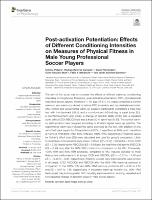Please use this identifier to cite or link to this item:
https://repositorio.usj.es/handle/123456789/333
| Title: | Post-activation Potentiation: Effects of Different Conditioning Intensities on Measures of Physical Fitness in Male Young Professional Soccer Players |
| Authors: | Petisco-Rodríguez, Cristina


Ramirez-Campillo, Rodrigo 


Hernández, Daniel Gonzalo-Skok, Óliver 

Nakamura, Fabio Y. 


Sánchez-Sánchez, Javier |
| Keywords: | Plyometric; Speed; Fatigue; Warm-up; Soccer |
| Issue Date: | 6-Jun-2019 |
| Publisher: | FRONTIERS MEDIA SA, AVENUE DU TRIBUNAL FEDERAL 34, LAUSANNE, CH-1015, SWITZERLAND |
| Citation: | Petisco C, Ramirez-Campillo R, Hernández D, Gonzalo-Skok O, Nakamura FY and Sanchez-Sanchez J (2019) Post-activation Potentiation: Effects of Different Conditioning Intensities on Measures of Physical Fitness in Male Young Professional Soccer Players. Front. Psychol. 10:1167. doi: 10.3389/fpsyg.2019.01167 |
| Abstract: | The aim of this study was to compare the effects of different warm-up conditioning intensities on the physical fitness (i.e., post-activation potentiation -PAP), of professional male field soccer players. Athletes (n = 10; age: 21.6 +/- 3.2 years) completed a control warm-up and warm-ups aimed to induce PAP, in random and counterbalanced order. After control and experimental warm-up sessions participants completed a triple hop test with the dominant (H3Jd) and a non-dominant (H3Jnd) leg, a squat jump (SJ), a countermovement jump (CMJ), a change of direction ability (COD) test, a repeated sprint with a COD (RSCOD) test and a linear 30-m sprint test (S-30). The control warm-up (WU) protocol was designed according to athlete's regular warm-up practice. The experimental warm-ups included the same exercises as the WU, with addition of one set of half-back squats for 10 repetitions at 60%, 5 repetitions at 80%, and 1 repetition at 100% of 1RM (60%-1RM, 80%-1RM and 100%-1RM, respectively.) Threshold values for Cohen's effect sizes (ES) were calculated and used for group's comparison. Likely to most likely improvements were shown in H3Jd (ES = 0.52), H3Jnd (ES = 0.51), COD (ES = 0.38), fasted sprint (RSCODb) (ES = 0.58) and the total time of all sprints (RSCODt) (ES = 0.99) only after the 80%-1RM protocol in comparison to the WU. Conversely, 100%-1RM and 60%-1RM protocols, compared to WU, induced possibly to most likely poorer performance in all jumps, COD and RSCODb (ES = -0.07 to -1.03 and ES = -0.48 to -0.91, respectively). Possibly to most likely improvements were shown in all jumps, COD, RSCODb and RSCODt after the 80%-1RM warm-up protocol in comparison to the 100%-1RM and 60%-1RM warm-up protocols (ES = 0.35 to 2.15 and ES = 0.61 to 1.46, respectively). A moderate warm-up intensity (i.e., 80%-1RM back squat) may induce greater PAP, including improvements in jumping, repeated and non-repeated change of direction speed in male soccer players. |
| URI: | https://repositorio.usj.es/handle/123456789/333 |
| ISSN: | 1664-1078 |
| Appears in Collections: | Artículos de revistas |
Files in This Item:
| File | Description | Size | Format | |
|---|---|---|---|---|
| fpsyg-10-01167.pdf | 587,6 kB | Adobe PDF |  View/Open |
This item is licensed under a Creative Commons License

